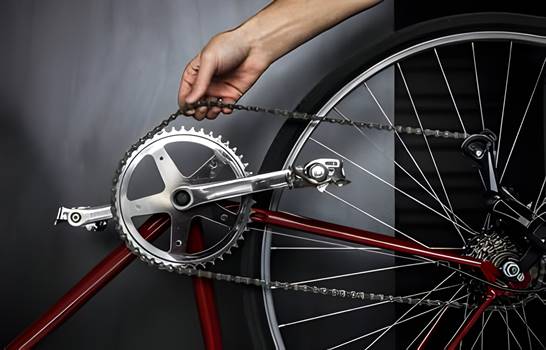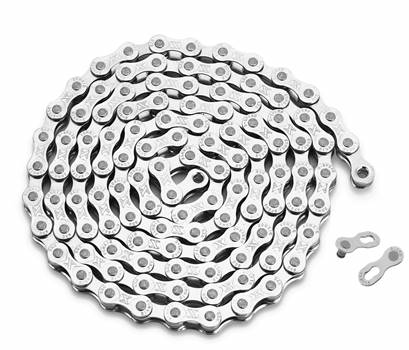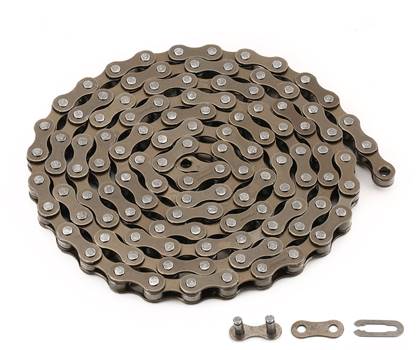Imagine yourself riding a bicycle through a beautiful wooded area or an open stretched road, feeling the freedom of the wind in your hair. Everything seems so smoothing and refreshing as you embrace the beauty of nature. It’s a perfect moment—until all of sudden, your bike chain begins to wobble and grinds violently. The smooth journey is suddenly cut short by the unknown sound of a broken bike chain.
Moments like these remind you of the importance of the quality of the bike chain and you find yourself questioning how long does a bike chain last? This is a very simple question and having an understanding of bike chain lifespan and maintenance can save you from a lot of trouble during your adventurous trips.
How Long Does a Bike Chain Last?
A well-maintained bike chain can last anywhere from 2,000 to 3,000 miles (3,200 to 4,800 kilometres). This range can be affected by variables such as riding circumstances, bike type, and maintenance routines. For example:
- Average lifespan of Road Bike chain is: 2,000 – 5,000 miles
- Average lifespan Mountain Bike chain (MTB) is: 500 – 1,500 miles
- Average lifespan of Electric Bikes chain is: 2,000 – 3,000 miles
Have you noticed your bike chain skipping, slipping, or making strange noises during rides? These could be signs that your bike chain needs to be replaced.
Don’t ignore these signs because it can also damage other parts of your bike.
What are the Symptoms of a Stretched Bike Chain?
The main symptom of a stretched bike chain is excessive wear. To verify excessive wear, measure the length of 12 complete links or use a chain checker tool. If the length exceeds the standard length, consider replacing it.
Another symptom of stretched bike chains is rust and corrosion on the chain links. Exposure to dirt and moisture over time may cause this. Not only does a rusty chain reduce performance, but it also wears down other drivetrain parts more quickly.
So, if any of these signs appear, consider replacing your bike chain and cassette for maintaining the overall performance of your bike.
How often should you Replace your Bike Chain and Cassette?
Ideally speaking, you should replace your bike chain every 2,000–3,000 kilometres. However, it might need to be replaced sooner if you see any wear signs or symptoms.
Although cassettes usually last longer than chains, it’s nevertheless advisable to replace them on a regular basis to guarantee seamless shifting. If your shifting becomes less accurate or the teeth seem worn down, it’s a good sign that your cassette needs to be replaced.
I would recommend you to invest in purchasing high-quality products to avoid the frequent replacement.
Here I’ve listed two top-ranked products of Amazon. The analysis is based on customer’s reviews. Do your own research as well but if you are short on time, you can choose from here. Have a look!
1. ZONKIE 6/7/8 Speed Bike Chain
Click here to see the latest price.
Pros:
- The Zonkie bike chain is of great quality.
- Easy to fit with the Magic link being a helpful feature.
- Offer smooth running.
- Less running noise.
- Reusable and affordable.
- Easy to disassemble and clean.
Cons:
- Not recommended for bikes with non-standard length.
2. ZONKIE Bike Chain Single-Speed
Click here to see the latest price.
Pros:
- Easy to install and disassemble.
- High quality construction.
- Magic link highlights ease of use.
- Produce less noise while running.
- Maintenance friendly
Cons:
- Not suitable for bikes that demand unique sizing requirements.
What is the Cost of Replacing a Bike Chain and Cassette?
Typically, the average cost of a new bike chain ranges between $30 to $100. On the other hand, cassettes usually cost $50 to $200 on average. Keep in mind that these prices can be varied depending upon the quality of the components you are choosing.
But simply knowing the symptoms, lifespan, and costs associated with chain replacement isn’t enough!
You need to learn more about the reasons behind the replacement of your bike chain. Continue reading to learn about those factors that lead to the replacement of your bike chain.
Factors that Affect the Lifespan of a Bike Chain
When it comes to the lifespan of your bike chain, there are various factors that you must consider. Here I’ll describe some of the significant variables that will determine the lifespan of your bike chain.
- Maintenance
Proper maintenance is essential. Maintaining your chain clean and lubricating it on a regular basis can help to avoid wear and tear.
- Riding Conditions
The riding conditions also play an important role in deciding how long your bike chain lasts. Chain wear can be accelerated by riding in muddy or wet conditions because of increased friction and debris accumulation.
- Type of Shifting System
The kind of shifting mechanism also affects the longevity of your bike chain. An incorrectly adjusted derailleur might put too much strain on the chain, which can wear it out sooner.
- Quality of the Components
The lifespan of your chain can be impacted by the calibre of the parts utilised in your powertrain. Purchasing chains and cassettes of superior quality might help your equipment last longer.
- Riding Style
Finally, riding style like selecting the right gear and how hard you pedal affect how quickly a bike chain breaks.
Now that we’ve identified the factors that can shorten your bike chain’s life, let’s shift our focus to tips to prevent wear and tear in your bike chains.
Tips for Extending the Lifespan of Your Bike Chain
If you want to extend the lifespan of your bike chain, play with these tips and tricks and you will be amazed by their magic:
Tip 1: Regularly Clean your Bike Chain
Make sure to clean off the dirt and grime from your bike chain to protect it from wear and tear. Moreover, lubricate it with a high quality lubricant to reduce the friction.
Tip 2: Avoid Cross-Chaining
Make smooth shifting through the gears and avoid extreme gear combinations as they result in putting excessive strain on the chain.
Tip 3: Maintain Proper Tension
Maintain proper tension in your bike chain but don’t over tight it. Always try to check the signs of wear regularly.
Tip 4: Invest in Quality Bike Chain
Quality is the key factor that must be paid great attention. Investing in quality products leads to longer-lasting use.
Final Thoughts
Maintaining the longevity and functionality of your bicycle requires routine maintenance and prompt replacement of the chain and cassette. You may save needless wear and tear, increase shifting effectiveness, and improve the riding experience overall by taking care of these parts.
In the end, taking the time and making the effort to maintain your bike chain will pay off in the form of enhanced functionality, longevity, and satisfaction each time you step on the pedals.
Frequently Asked Questions
How long does a MTB chain last?
A mountain bike chain (MTB) can last up to 750 miles of single track riding.
How long does a dirt bike chain last?
Usually, a dirt bike chain lasts up to 15,000 to 30,000 miles if you maintain it regularly. However, this analysis is based on a broad spectrum and it could be different depending upon different usage.
How long does a waxed bike chain last?
A waxed bike chain lasts up to 300-500 km (190-310 miles). However, it can be varied depending upon how well you maintained it.
How long does a bike cassette last?
It depends upon several factors including riding style, landscape, maintenance, and quality of cassette. Usually, a high-quality cassette can last up to 10,000 miles or longer with the right maintenance. Conversely, a poor-quality cassette can only survive up to 1,500–2,000 kilometers.
How long does the 11-speed chain last?
Many cyclists report that the average lifespan of an 11 speed chain is approximately around 17,00 miles. After that, you have to replace it. It can be varied depending upon its usage, type of terrain and weight of rider.
How often should you replace bicycle chains?
Typically, it is recommended to change your bicycle chain every 1,000 to 2,000 miles (1,600 to 3,200 kilometres) in order to maintain peak performance and avoid undue strain on other powertrain parts. However, to determine the ideal time for a replacement, routine maintenance and inspection are necessary.
How long does it take to replace a bike chain?
If the correct tools are used and one has some basic mechanical knowledge, replacing a bike chain usually takes 30 minutes to an hour. The process entails taking off the old chain, sizing the new chain, and mounting it on the bike.


